|
By
the mid-1940s and the close of World War
II, the Hayes Code, which explicitly
said what explicit material could and
couldn't be shown on movie screens, was
starting to show a few cracks. Exploiting
these new fissures were a group of
independent filmmakers, who were doing
their damndest to get a naked body on the
big screen -- and out of the stag reels
relegated to your local Elk's Club
basement. Sure,
nudity was nothing new. Pioneered with the
likes of Kroger Babb's Mom
and Dad,
disguise any film as a documentary piece [Bowanga!
Bowanga!]
or educational
short [Test
Tube Babies],
and you could usually sneak it past the
local censorship boards. If that failed,
the distributors resorted to the old
"square-up" reel, where exhibitors
were given two different copies of the film
-- one a cleaner version used to get past
the censors, and then the other that they
would really show, complete, once they got
the OK. And if the theater owner smelled
out the cops or a sting, the tamer version
was shown until the authorities cleared
out, and then the square-up
reel would be tacked on at the end
to show what everyone had missed.
Then
came the burlesque movies -- nothing more
than a static recreation of an old
vaudeville show, consisting of corny
comedians and comely strippers, which
opened the door for the nudist pictures (--
nature films and nudie camps, etc.),
and one film in particular called Garden
of Eden.
For it was with this film, after a lengthy
court battle, a ruling was handed down
that stated:
"Nudity,
on it's own, had no erotic content and
therefore is not obscene."
--
Quoting from RESEARCH
#10: Incredibly Strange Films.
Though
the ruling didn't completely break the
Hayes Code's back, it did turn those
cracks in the foundation into a full-blown
breach. And what followed next, starting
with Russ Meyer's The
Immoral Mr. Teas,
was a new type of film that combined the
corniness of the burlesque shows with
the not-quite full-frontal of the Nudies
-- and thus, the Nudie-Cuties were
born. Voyeurism was still the game:
lot's of looking, but no touching --
from the audience, or the characters on
screen; just a parade of beauties and a
lot of teasing, teasing, and more teasing,
punctuated by a whole lot of corn, straight off the cob;
that's a
Nudie-Cutie
in a kernelled nutshell. And when this cycle
started petering out, oddly enough,
monsters started showing up, giving the
genre one last hurrah with the likes of Kiss
me Quick,
and this week's film, House
on Bare Mountain,
before the real monsters and
psychos started showing up -- but we're
getting ahead of ourselves a little bit.
Now,
it's usually at this juncture that I
give you the plot description of the
film, but that would be admitting that House
on Bare Mountain
had a plot to begin with. And to do so
would prove the Supreme Being of your
choice fallible -- thus
starting a chain reaction that would
null and void the entire universe. And
who wants to be responsible for that?
Not me. Heck, no.
Okay.
Okay. Fine...
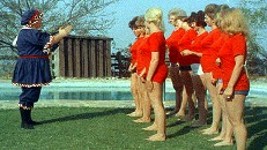
The
plot, I think -- and stress on the
think, revolves around Granny Goodbody
-- producer Bob Cresse in drag -- and
her school for wayward young girls. And
Cresse's take on Goodbody is a
flattering carbon-copy of comedian
Jonathan Winter's Granny Fricker
character in the same way Sammy Petrillo
was flattering Jerry Lewis in Bela
Lugosi meets the Brooklyn Gorilla.
Anyway, Granny's curriculum for her
girls mostly consists of spending a lot
of time in the shower, getting ready for
bed, lounging around the pool, or
exercising around the grounds of her
mansion. Of course, everyone -- except
for Granny, thank the Deity of your
choice -- is
topless and sometimes bottomless (--
but only from the rear.)
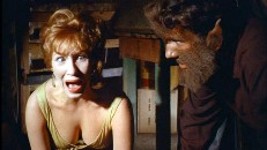
The
film proper opens with Granny in the
clink. Why? Well, as a side operation, she
sells liquor made by an illegal still out
of her basement that's run by her pet
werewolf, Krakow. (Make
up provided by Harry Thomas, and it's just
as shoddy as his work in Frankenstein's
Daughter.)
Relating her tale of woe, Granny
was suspicious that a spy was in her
midst, and then spends most of the movie via a
flashback trying to ferret the mole out --
and you won't believe where she looks.
Let's just say every nook and cranny is
checked and re-checked and then leave it to your
imagination.
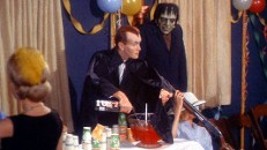
Things
eventually reach a climax at the Halloween Jamboree,
where in an extended sequence, each
topless border is shown flopping down the
steps to call their dates, begging those
on the other end of the line to sneak a bottle of
booze into the dance. They all do, and
after the punch is spiked to around
190-proof, the mole reveals herself, calls
in the cops, who then raid the place, while the
party degenerates into a drunken dance
orgy, complete with the Frankenstein's
monster doing the Watusi.
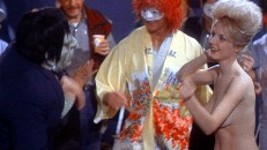
And
that's about it, except for the twist
ending. Turns out Granny got all the cops
drunk, too, and keeps them all imprisoned
in her basement, forcing them to work the
still. (She
wasn't in the clink, they were.)
The
End
In
the relatively tight circle of early
sexploitation film pioneers, the only
person disliked or more reviled by his
peers than Alan Shackelton was probably
Bob Cresse. Dave Friedman (The
Defilers, Scum of the Earth),
a long time collaborator, called him
"a closet Nazi" and Harry Novak (The
Pigkeeper's Daughter, A Scream in the
Streets)
threatened to throw him through a
plate-glass window if he tried his strong
arm tactics on him again; and for the
record, those tactics usually included a
loaded .38 and two beefy body guards for
persuasion and bill-collecting.
Cresse
started out as a messenger for MGM, but
felt there was more money to be made
working independently -- especially
concerning subjects the big studios
weren't allowed to do. Striking out on his
own, he founded Olympic International
Pictures, whose simple motto was "Art
for the Sake of Money." Getting
his feet wet writing and producing Once
Upon a Knight
-- a tale of an insurance investigator
whose allergic to naked women, Cresse then
got involved with the House
on Bare Mountain
by bailing out fellow producer Wes Bishop,
who ran out of money one day into
production. Hooking up with another long
time collaborator, director Lee Frost,
Cresse inserted himself into the picture
as the star, ad-libbing the whole thing,
and only shot one more day of footage, and
then spliced everything together. The
ad-hoc style of filming shows up pretty badly
during the film's brief running time (--
it barely breaks an hour). There
just ain't a whole lot there, and what is
there borders on tedious, and the thing
never quite gels and lacks the overall
delirium of the far superior Monster-Cutie,
Novak's
Kiss Me Quick or Ed Wood's Orgy of the Dead.
Now,
despite those earlier court rulings, some local
censorship boards were still throwing
their weight around. And when House
on Bare Mountain
premiered in Boston, the Chief of Police,
claiming to have seen a little bit of
snatch during the screening, raided the theater
and shut the movie down. Demolishing the
projector, he arrested the owner and
burned the negative on the sidewalk
for the gathered press outside
(--
turns out he was up for re-election at the
time). Cresse counter-sued for
destruction of property, and since the
evidence was destroyed, giving the cops no
case, he won a settlement.
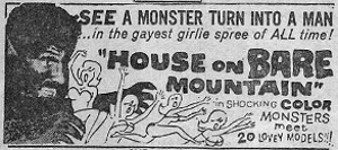
The
end was soon nigh for the Nudie-Cuties
though, and the giddy colors and jiggling
scenery were replaced with the darker,
grittier and nastier Roughies as
the teasing gave way to sex with an unhealthy
dose of violence. And as the characters
starting fondling each other, and more,
they usually just wound up beating the
crap out of each other; evidenced in the
bondage and sadism of George Weiss's Olga
movies; the Findley's sleaze and
necrophilia -- and if you thought the
lobster claw assault in Kiss
of Her Flesh
was bad, check out the corn cob scene in The
Ultimate Degenerate.
Gah!; and then culminated with the
all out gorenogrpahy of Hershell Gordon
Lewis (Blood
Feast, 2000 Maniacs
etc.), which officially put an end to -- no
matter what there was to look at, c'mon,
admit it with me -- one of the dumbest
genres off all time.
Cresse
went with the flow, churning out the
wonderfully sleazy Mondo
Bizzarro,
The
Animal,
and the truly nasty western, Hot
Spur,
where a cowhand kidnaps and tortures the
boss's wife, followed by
The
Scavengers,
his take on Peckinpah's The
Wild Bunch,
only here, the rapes are shown in slow-motion;
and Cresse was also responsible for the
very first, and some think the worst, of
the Nazi-sexploitation-sickies, Love
Camp 7, where he had a little too
much fun playing the Commandant -- if you
know what I mean. And
by most accounts, Cresse was just as big a
misogynistic misanthrope in real life as
he was in that film. It's my understanding
he had a two-way mirror in his office that
gave him full view of the ladies restroom
-- that lets you see what, exactly?
Shower? Sure. But a restroom? Which makes
what happened to him next even more
bizarre:
While
taking his dog for a walk along Sunset
Strip, down an alley, Cresse heard a woman
crying for help. He investigated and found
two men, who appeared to be assaulting her.
Pulling out his trusty .38, when Cresse told
them to back off, one of the men
pulled out his own gun, shot Cresse in the
stomach, then shot and killed his dog for
good measure, and then informed Cresse
that they were police officers making an
arrest. And while recuperating from his
injuries, Cresse bled his accounts dry
with medical bills. Broke, he dissolved
his partnership with Frost and bowed out
of the production business, taking a few
bit parts here and there, and at one point
wound up skipping the country to get away
from his creditors. He eventually did come
back and died of a heart attack in 1998,
ending one of the strangest runs in
filmdom.
Although
he might not have been the nicest guy in
the business, the one positive thing you can say
about Cresse is that he always delivered
what his titles and promotional material
promised. I'll
admit there is something refreshing about
watching these old Nudie films, and that's
the -- for lack of a better word -- naturalness
of the eye-candy on display. No silicone
perfection or over-fixed grotesqueries,
and no waifish, heroin chic. These ladies
are what they are, tan lines and all; cute
and solid and comfortable, and there ain't
one damn thing wrong with that.
|